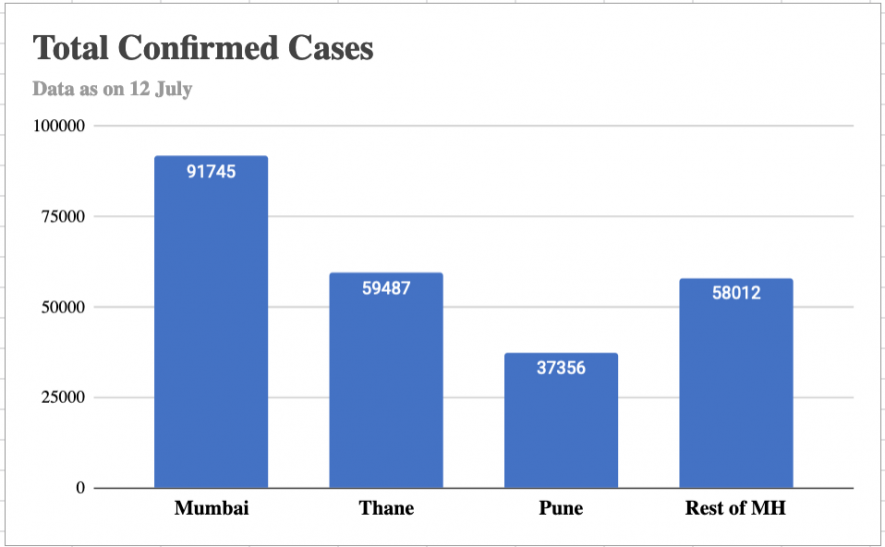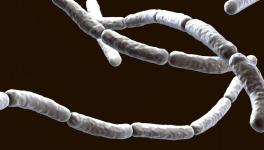COVID-19: Maharashtra’s challenge in tackling the new, emerging hotspots

While the Thackeray government can certainly find succour in the Dharavi success story, praised by WHO Director-General Tedros Adhanom Ghebreyesus as an example that has “shown that even if the [Covid-19] outbreak is very intense, it can still be brought back under control”, it is a matter of serious concern that the pandemic is raging in the rest of Mumbai and some important urban districts of Maharashtra. Apart from Mumbai, seven districts of the state figure in the list of top 20 most-affected districts in the country. They include Thane, Pune, Palghar, Aurangabad, Raigad, Nashik, and Jalgaon.

The three most prominent urban districts of Mumbai, Thane and Pune, as Figure 1 shows, are witnessing an average increase week-on-week in the number of confirmed cases, Mumbai’s figure in the week of July 5-11 notwithstanding.
Mumbai continues to top the all-India list of districts with the most number of confirmed Covid-19 cases, which is 91,745. The neighbouring district of Thane has the third highest number of confirmed cases in India, with 59,487.
While the state saw 8,139 new confirmed cases being reported on July 12, the highest one-day jump so far, the week July 5 to July 11 witnessed a decrease in the average number of cases per week with 8,508 against the previous week’s 11,062. Thus the respite last week, might just be that, a respite.
Thane too witnessed a slight fall in the number of confirmed cases with a weekly average of 13,654, while the previous weeks have seen a steady rise in that number (See Figure 1).
Mumbai Suburban district boasts of a population density of 20,980 people per sq km, Mumbai City 19,652 people per sq km, while Thane has 1,157 people per sq km, according to Census 2011; together they account for 61.32% of confirmed cases in the state. When Pune’s 15% of confirmed cases in the state is considered, nearly 76.47% of all cases in Maharashtra are from these three urban districts. That figure would acquire better perspective if testing figures were available district-wise as well. The state-wide figure for the cumulative number of tests done is all that is made available and that is 1,321,715, as of July 12.

The government has responded to these rising figures with announcements that Pune and Pimpri-Chinchwad will be under lockdown for 10 days from July 13. It has also decided to extend the lockdown in places like Thane, Kalyan-Dombivali, Mira-Bhayander and Mumbai itself till July 19.
The rationale for lockdowns is to allow authorities to shore up infrastructure, while the spread of infections are contained for the period of the lockdown. Does that mean the health infrastructure will be ramped up in the next 10 days?

The current status of health infrastructure figures in the three districts, Mumbai, Thane and Pune cumulatively account for about 1,091 (43%) of the 2,544 health facilities in the state. The three districts put together have 1,654 ventilators, which account for about 47% of ventilators available in the state, while the 5,509 ICU beds account for about 50%. The steady rise of cases and the stress on the health infrastructure calls for a rapid increase in capacities.
A close look at the data reveals that the number of new cases in the rest of Maharashtra has crept up even higher than Thane in the week July 5-11, as shown in the chart below.

Note:
Category-I Dedicated COVID Hospitals(DCH)
Category-II, Dedicated Health center(DCHC)
Category-III, Dedicated COVID Center(DCCC)"
Source: https://arogya.maharashtra.gov.in/1177/Dedicated-COVID-Facilities-Status
With the steady rise in confirmed cases in Palghar (9,343), Raigad (8,010), Aurangabad (7,995), Nashik (6,884), and Jalgaon (5,601), the disproportionate focus on the top three districts will only lead to Maharashtra stumbling from crises to crises in one region or another.
A look at the trend line chart with a moving average clearly indicates that Maharashtra needs to prepare for what is to come, and focus on the districts that have not hit the headlines yet. The obvious waves in the rest of Maharashtra trend line is a result of cases being categorised as “unknown”, probably a result of patients not being able to tell where they were from.
If one were to look at the proportion of daily confirmed figures for Mumbai, Thane, Pune, and the rest of Maharashtra, the capital of the state accounted for as much as 58% of the confirmed cases on June 1, while Thane accounted for 14.2% and Pune 11.49%, while the rest of Maharashtra was just 15.61%. On July 11, those numbers stood at Mumbai 37.20%, Thane 24.12% and Pune 15.15%, but the rest of Maharashtra has reached 23.52 per cent.
The Thackeray government should thus be focussing on arresting the growth trajectories in at least districts like Raigad, Palghar, Aurangabad, Nashik and Jalgaon, even as it continues to bring figures down for Mumbai, Thane and Pune.
Palghar, which till recently was part of Thane district, and Raigad, both in the Konkan region of the state, are seeing new cases rising in the past couple of weeks. Raigad even has recently surpassed Palghar.

Aurangabad in the Marathwada region is a district which has seen a sharp increase in the number of new cases in the past two weeks. The neighbouring districts of Jalgaon and Nashik are not far behind either. Solapur in Paschim Maharashtra, Nagpur and Akola in Vidarbha region have also witnessed a steady rise in new cases. What this indicates is that the pandemic has well and truly spread across all regions of the state. While initially Vidarbha seemed relatively unaffected by the onslaught of the virus, it isn’t the case anymore.
If Thane’s proximity to Mumbai ensured that the district saw an early surge in the number of cases, Palghar’s rising new cases indicates that the district can be the next hotspot. Neighbouring Raigad too is already close behind Palghar.

Aurangabad being Nashik’s neighbour, the district is seeing a rise in new cases as well. With Pune being severely affected, Solapur is seeing new cases rise fast. Contiguous districts would have to be on high alert if the pattern of the spread is anything to go by. The rate of rise in new infection in contiguous districts also indicates that under-developed districts will soon have to contend with rising number of cases.
Maharashtra is not in any position to look at either help or solutions from the Centre. The ruling Bharatiya Janata Party continues to be more focussed on toppling state governments run by opposition parties or on upcoming elections, and its own response to the pandemic has been woefully inadequate and fatally muddled. Maharashtra’s success in containing the Dharavi crisis was due to Health Minister Rajesh Tope reaching out to the Kerala Health Minister K K Shailaja to understand the “Kerala Model” and then subsequently seeking medical expertise from the Left Front Government in Kerala. The need of the hour is to look at and learn from more such local examples across the nation in order to expand on the success of Dharavi and bring the pandemic under control in the entire state.
Source of data where not mentioned is from https://www.covid19india.org/
Get the latest reports & analysis with people's perspective on Protests, movements & deep analytical videos, discussions of the current affairs in your Telegram app. Subscribe to NewsClick's Telegram channel & get Real-Time updates on stories, as they get published on our website.
























